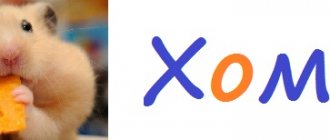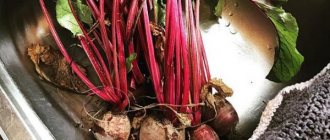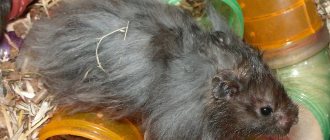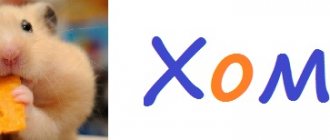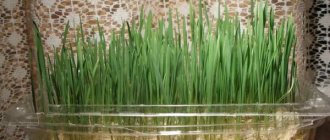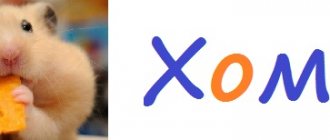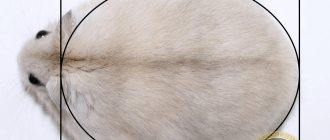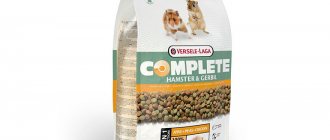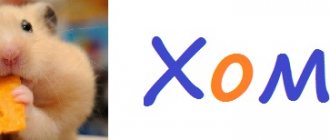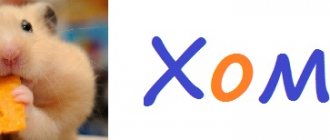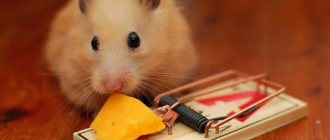Summer is the main time for fruits, berries and vegetables. Every owner wants to please their pet, but before that it is important to find out whether hamsters can have watermelon and what the reaction will be to the berries. Find out which vegetables to include in the menu and find out which fruits will not harm your pet.
Hamsters are prohibited from sweet foods: reasons
According to scientific research, there are a number of plant products that have a negative effect on the body of rodents. In the list of similar products you can find watermelon and melon. Carelessness and inexperience lead to hamsters becoming poisoned due to improper nutrition. This causes constipation or the development of diarrhea. Therefore, in order to avoid death, owners should take into account that the digestive system of their little pets is very sensitive, and the stomach is not always able to digest human food.
As a result, the answer to the question whether hamsters can eat watermelon is obviously negative. After all, the berry consists almost entirely of water, which leads to severe diarrhea. It should be noted that the pulp of the fruit deteriorates quite quickly, and this leads to poisoning. Many watermelons are grown using various chemical additives that are dangerous to the body.
Can a parrot have tangerines?
You can and should give your parrot tangerines, because they are a source of vitamin C, the strongest natural immunomodulator. In addition to this useful vitamin, tangerines contain other substances necessary to maintain health: vitamins A (retinol, beta-carotene), B1, B12, E, D and a number of others. Mandarin is used as a vitamin supplement, treat, and not the main meal.
The vitamins your pet needs are sold in veterinary pharmacies in the form of tablets or suspensions, but natural sources of these beneficial substances have some advantages:
- easy digestibility: all elements pass from the fruit pulp directly into the body;
- naturalness: if the fruit has not been subjected to chemical treatment, the beneficial substances are preserved in its original form.
Thus, tangerines are useful not only for people, but also for feathered pets. They enrich the body with calcium, iron, sodium, etc. If you give your budgies tangerines, the microelements they contain will have a positive effect on the functioning of the body and strengthen the immune system.
How to give correctly
First of all, you should observe the measure: the weekly norm for large individuals is two whole tangerines. For smaller parrots, 1-1.5 pieces is enough. Excessive amounts of fruit lead to hypervitaminosis or allergies. Citrus fruits for parrots, as for people, can become allergens at any time. Intolerance is caused by elements such as vitamins C, A or E.
Like all new foods, tangerines are introduced into a parrot’s diet gradually so that the pet has time to adapt to an unfamiliar product. They start with small pieces and at the same time carefully monitor the behavior of the bird: has its mood or appearance changed in a negative direction? If everything is in order, the number and size of portions are increased. Some individuals may not like the taste of the new treat. In this case, all that remains is to remove the treat and not offer it again.
The tangerine peel is first removed. It contains essential oils, which in large quantities are dangerous for the respiratory tract. In addition, the possibility of treating the fruit with chemicals, which will subsequently settle in the peel, cannot be ruled out. The films between the lobules are also removed so that the pet does not accidentally choke.
Even if the parrot is not against eating as many tangerines as possible, the owner should restrain this desire, because he is responsible for the health of his pet.
What vegetables can you give hamsters?
The vegetables hamsters like to eat most are:
- red pepper;
- tomatoes in small quantities;
- carrots;
- radishes;
- pumpkin;
- zucchini.
To guarantee, it is advisable to peel ripe fruits. It is strictly forbidden to give your pets cabbage, which can cause bloating, as well as difficult-to-digest potatoes.
Most owners still cannot come to a conclusion whether it is possible to give watermelon to a hamster. The fact is that early cultivation of berries and vegetables in greenhouse conditions using nitrates can have a detrimental effect on the health of not only humans, but also animals. You can feed your pet only with foods that you have grown yourself. So, you shouldn’t take the risk and feed your hamster purchased watermelon. Food that makes a person feel unwell can cause poisoning in a pet.
Vintage basket
Here we are dealing with a representative design in the style of modern rural fashion. Best suited for lovers of cycling or short distance travel on scooters. The basket itself is woven from flexible willow and equipped with an openwork wire lid, which prevents the cat from wanting to get out while moving. At the first glance at such a carrier, one is reminded of idyllic pictures from centuries ago, when food from the market was transported in a similar way on bicycles. The entire structure is conveniently attached to the steering wheel using leather straps and does not require much time for preparation.
The advantage of the option under consideration is, of course, its original design and originality. The downside is limited functionality. Although, if desired, the basket can be used for its intended purpose.
Price – 1,128 – 1,708 rubles.
Can Djungarian hamsters have watermelon or melon?
Melon, like watermelon, is a healthy product for the human body. But, unfortunately, the hamsters’ body is structured a little differently. A significant amount of sucrose in some products causes significant harm to the health of small pets. Watermelon is especially contraindicated for dwarf breeds, which have a tendency to develop diabetes.
Vegetables and fruits that can be seen on store shelves ahead of time are grown using chemical fertilizers. Chemicals that penetrate through the skin into the flesh may not harm a person, but for an animal it will be a lethal dose and a serious disorder.
However, scientists have found the answer to the question of whether hamsters can eat watermelon. It is recommended to include dried melon or watermelon in your diet. In this case, the pieces will need to be crushed and mixed with other products. Such treats, like melon or watermelon seeds, should be given to hamsters with caution and in small quantities.
Sunflower seeds
This product contains a huge amount of healthy fat-soluble vitamins (A, E, D, group B), minerals (iron, magnesium, fluorine, zinc, iodine, calcium), amino acids and polyunsaturated acids
All this is very important for any organism, especially for a tiny hamster
Eating sunflower seeds helps lower cholesterol levels and slows down the aging of body cells. These seeds are included in most ready-made food for hamsters. But with frequent feeding of sunflower seeds, the hamster’s metabolism is disrupted. So give your pet a little of this tasty treat.
Watermelon seeds: benefit or harm
After the owners of their pets received answers to the question of whether hamsters can eat watermelon, others are brewing. As is known, the pulp and peel are dangerous for rodents. Therefore, many people doubt whether watermelon seeds can be consumed by rodents. It turns out that seeds can be included in your pet’s diet if you wash and dry them in advance. Melon seeds are also pre-prepared to remove sugar.
Peppermint treat
Ingredients:
- 1 medium overripe banana.
- 2 chicken eggs.
- 3 tbsp. spoons of honey.
- 3 tbsp. tablespoons of liquid coconut oil (can be replaced with sunflower oil in the same amount).
- 1/2 teaspoon mint flavoring.
- 1/2 teaspoon baking powder.
- A quarter cup of carob (roasted carob powder). A small amount of cocoa can be substituted, but this is not recommended for animals. Therefore, try to find an original product.
- Oat flour.
Cooking procedure.
1. Mash the banana in a bowl.
2. Beat eggs into the resulting mass, add honey, baking powder, cinnamon and coconut (sunflower) oil.
3. Add oatmeal to the mixture to form a firm but slightly moist dough.
4. Divide the resulting volume into 2 equal parts.
5. Pour 1/4 cup of carob powder into one half, and add the same amount of flour to the second half. A hard lump should form that does not stick to your hands.
6. Roll out 2 rectangles, 9-10 mm thick.
7. Place the layers of dough on top of each other and roll along the long side. Wrap the resulting sausage in plastic wrap and put it in the refrigerator overnight.
8. Preheat the oven to 180 degrees.
9. Cover a baking sheet with parchment paper.
10. Remove the film and cut into 3-3.5 cm rounds.
11. Place on a baking sheet. During cooking, portions of dough will not increase in volume, so you can place them close to each other.
12. Bake for 10-15 minutes.
If you want to please your pet with a crunchier treat, cut the rolls into thin slices (about 1 cm), and after cooking, additionally dry them in a warm oven or even in a non-stick frying pan.
The finished product is stored for a long time in a dry place. So, by baking peppermint rolls once, you can treat your four-legged pupil with them for a long time.
Bon appetit to your dog!
I like it I don't like it
What harm can the seeds cause?
Like any food, seeds do not always benefit the body. Therefore, you should determine in advance whether hamsters can eat watermelon and its seeds.
The damage to seeds is as follows:
- High calorie content. You can do a simple experiment to see if hamsters eat seeds first. If you buy dry food in a store and pour it into a bowl, you will notice how hamsters will feast on just such food with great appetite. However, to avoid obesity, it is recommended to impose restrictions on the number of seeds consumed per day.
- Large amount of fat. As you know, some seeds contain excessive amounts of oil. With systematic consumption of seeds, the hamsters' liver can no longer cope with the load, which leads to death.
- Husk. You can be sure that not all store-bought food contains hulled seeds. Owners do not always realize that seeds with husks are harmful to the health of their pets. Although hamsters love to have fun trying to remove their shells, the consequences can be unpleasant for many rodent species. When trying to hide the seeds in the cheek pouches, they may get stuck, and the peel may be injured by the sharp edge.
Therefore, if you are not sure whether Djungarian hamsters can be given watermelon, it is recommended to pay attention to the seeds. However, they should be included in the diet with caution. And, despite the fact that a rodent’s attempts to stuff seeds into its mouth looks exciting, you should understand that the entertainment can end in disaster.
Bones - in a separate line
Whether watermelon seeds can be given to hamsters depends on their quantity and proper preparation. The grains must be clean, without nitrates. It is better to offer rodents watermelon seeds grown in your own garden. Before feeding, you need to rinse them well, then dry them in the oven.
Beneficial properties for the hamster body
Watermelon seeds, like sunflower seeds, have a rich biological composition.
They contain:
- B vitamins, which help strengthen the hamster’s immunity and maintain the normal functioning of the digestive system;
- micro- and macroelements take an active part in metabolic processes;
- vitamin D is necessary for maintaining the bone skeleton;
- polyunsaturated fatty acids are responsible for the animal’s healthy coat, its normal coordination of movements and the functioning of the cardiovascular system.
For large pets, watermelon seeds serve as a good entertainment that helps to further grind down the teeth.
Harm and restrictions on use
Watermelon seeds are a source of a large amount of useful substances, but if consumed incorrectly, they can cause harm to the hamster. The reason is as follows:
- Watermelon seeds are considered a high-calorie product and if a large amount is consumed, the weight of a rodent can greatly increase. This causes the development of various diseases and shortens the life of the animal.
- The seeds contain fat, and consuming foods high in fat has a negative effect on liver function. Hamsters are allowed to give only a few watermelon seeds and in no case should they be fried.
In addition, watermelon seeds are quite large and, if the animal wants to push them into the bags behind the cheeks, they can get stuck. It is recommended to give seeds to pets in purified form and only individually. It is strictly forbidden to offer a rodent a whole handful of seeds, as it will try to sell the reserves for future use and may die.
Syrian hamster diet
Unlike Djungarian hamsters, Syrian rodents are not contraindicated in vegetables such as carrots, pumpkin, cucumber and zucchini. Hamsters of this species should be fed twice a day. This regime meets the physiological needs of pets. The required amount of nutrition depends on the age category, size and individual abilities, as well as living conditions.
Many owners prefer to use dry food, which, as you know, is not suitable for all hamsters. Therefore, all kinds of treats are often used, which not only give pleasure to rodents, but also wear down their incisors.
It should be noted that all food should be washed thoroughly before offering it to your hamster. It is imperative to ensure that the animal’s diet is balanced. The diet should be based on exclusively healthy foods. But whether Syrian hamsters can have watermelon is up to each owner to decide for himself.
Among the representatives of the Syrian breed you can often find those who tend to rapidly gain excess weight. Therefore, special attention should be paid to nutrition.
The following products are acceptable in the diet of a Syrian hamster:
- cereals: oats, barley, millet, rice, wheat;
- legumes: peas, boiled beans, peanuts;
- sunflower seeds, pumpkin seeds;
- corn: fresh and dried;
- any vegetation;
- fresh fruits: apples, pears, bananas;
- vegetables: carrots, zucchini, cucumber, turnip;
- dairy products;
- special complex of vitamins.
So, the health and well-being of rodents depends on a well-chosen and balanced diet. The desire to please your pet with a treat can turn out rather disastrously. Therefore, you should find out in advance whether hamsters can eat watermelon. This depends on many individual characteristics of their body. It is strongly recommended, whenever possible, to buy fresh products or those grown on your own property to avoid chemicals getting into your little pet’s body.
Interesting Facts
The Dzungarian hamster was first discovered in 1773 by the famous scientist and traveler P. S. Pallas during an expedition to the regions of modern Kazakhstan. The description he gives is so elegant and accurate that it is worth citing it in its entirety: “The Zungor mouse (Mus sungorus) looks exactly like a hamster, but is smaller in size than a land mouse. The front paws are four-toed, the big toe is small without a nail. The body and legs are short. The tail is short and round.
The color on the back and head is gray, with a black stripe along the back, the sides are multi-colored; there are white spots along them, between which dark stripes sag towards the back, of which the first comes out from the ears and extends in a curve to the shoulder blades, the second is triangular in front of the shoulders, the third goes down along the back, between it and the sagging dark stripe there are also white spots. The entire animal, as well as the legs and tip of the tail, are white.
This curious animal is located on the hilly dry fields in the midday country near the Irtysh. A hole with many holes, to which a long passage extends under the very surface of the earth; but among the males it is simpler. She gives birth in June in groups of six and seven, and the young grow up quickly. They come out of the hole during the day.”
- In winter, Djungarian hamsters do not hibernate, but actively move along the surface of the snow in search of plant seeds.
- Having gone far from the hole, he often leaves the collected food in some secret place on the way home. And then, for example, the next day, he comes and picks up the stock.
- Hamsters molt; their fur color begins to change at prolonged temperatures below sixteen degrees. - Its fur is fluffy, in summer it is gray, there is a noticeable dark stripe along the ridge (a good distinguishing feature), in winter the rodent lightens and the coat becomes silver-gray.
- In the Altai region they are found up to an altitude of 3000 meters above sea level.
- The burrows of Djungarian hamsters are not very branching passages, with a couple of holes and a couple of chambers.
- Djungarians are nocturnal creatures, their peak activity occurs in the evening and at night, but during the day they sleep.
- In severe frosts, which require large amounts of energy, hamsters of this particular species can fall into a state of torpor for several hours, while their body temperature drops by 20°C. This phenomenon of so-called torpor was described by us in laboratory conditions (animals were kept at low temperatures), and then confirmed in nature (thermal radio transmitters were used). Interestingly, torpor occurs in these animals not only at low temperatures, but also under stress or lack of oxygen.
- The life expectancy of the Djungarian hamster is on average 2.5 years.
https://zootyt.ru/rodents/kormlenie-gryzunov/chem-pitayutsya-dzhungarskie-khomyaki-v-domashnikh-usloviyakh.html
https://fishki.net/2425665-pro-dzhungarskih-homjachkov.html
Let's diversify food
When turning to the veterinarian, many people ask the question: “Can a hamster have watermelon seeds?” The answer is categorical - no, they are included in the list of prohibited products, like cones and nuts in shells. By eating such food, a hamster can easily clog the bags that are located behind their cheeks and simply break their teeth. It is very difficult to treat an animal; it is better to take precautions. As for regular seeds, they can be given as a treat no more than twice a week.
Dry food for hamsters must be alternated with other food products. Vegetables must be present among them: carrots, pumpkin, beets. They should be offered fresh, pre-cut into thin slices or strips. Don't forget to rinse them with boiled water. Giving potatoes and white cabbage to the animal is strictly prohibited.
You should also take care of greens for your hamster. You can buy special grass that is sold in pet stores or grow it yourself. If this is not possible, dandelion stems and clover, which grow away from the highway, will do.
As for dairy products, you can periodically treat the animal with cottage cheese and low-fat cheese.
List of do's and don'ts
The list of foods that will negatively affect your rodent's health is not so small. It is worth remembering it, or better yet, writing it down, so that you never make a mistake when giving another treat to your hamster. So, hamsters should not eat foods such as:
- Cheese (in any form of any kind);
- Food for other animals (parrots, birds and other rodents);
- Potatoes (in any form);
- Persimmon (a variety that knits);
- Acorns;
- Drops for rodents;
- White and black bread;
- Crispbread (spicy with seasonings);
- Brazilian nut;
- Salt;
- Sugar;
- Spices (any);
- Butter;
- Citrus;
- Almond;
- Muesli and breakfast cereals;
- Onions (leeks and onions);
- Garlic;
- Bones (cherry or apricot);
- Potato peel;
- Cabbage (white and red);
- Sausages (any);
- Milk (cow and goat in any form);
- Sour cream;
- Cream;
- Exotic fruits and aphrodisiacs (kiwi, pineapple, pomegranate, avocado);
- Fried and fatty foods;
- Pasta (dry);
- Watermelon;
- Sorrel;
- Kozinaki;
- Mushrooms;
- Honey;
- Coniferous branches (pine, spruce, spruce, larch, etc.);
- Fruit juices;
- Mint;
- Tulip;
- Insects (caught from nature);
- Greens (picked within the city or near roads);
- Figs;
- Ice cream;
- Chocolate;
- Cookies (any other sweets).
Now, knowing exactly what you can feed your hamster, you can properly organize its nutrition and keep it healthy. Remember that proper care of your pet, even such a small one, will give you and him many years of joy.
Why do we need cheese?
Procuring food for themselves, these rodents eat insects, as well as various worms and larvae, this is the source of protein for them when living in the wild. In order to compensate for the lack of protein food, it is recommended that pets add special food to their diet. It could be a bloodworm, mealworm or gammarus.
But it is worth noting that domestic rodents are not always happy to eat such food, in which case the owners try to diversify the pet’s diet with food from the table, but this is not always correct and can result in disastrous consequences for the pet, health problems, and sometimes even death . To understand whether cheese can be given to rodents, you need to understand the composition and benefits of this product.
Harmful or beneficial?
Surely, many people know that the main ingredient for making cheese is milk, but this is far from the only ingredient. Sourdough and rennet are added, as well as auxiliary ingredients, including salt, spices and much more.
Unfortunately, recently, manufacturers of this product have begun to use insufficiently good components, as a result, the quality of the cheese has decreased. Many cheeses contain products that can be harmful not only to rodents, but also to humans. The baby’s body will most likely react to an inappropriate product with indigestion.
If you are confident in the high quality of the product, you can safely offer it to your hamster.
It should be low-fat cheese. A small portion will only do you good.
Cheese fills the animal’s body with the following components:
- Protein.
- Amino acids.
- Vitamins.
- Microelements.
If you notice that your pet enjoys eating cheese, then you need to choose a quality product for him.
Which product is contraindicated?
You need to understand that many types of cheeses are very fatty. They may contain salt, seasonings and flavorings. These components are added to make the product more tasty and attractive to the consumer. This type of food is strictly contraindicated for animals.
Such food can lead to disruption of internal organs. You will be able to see for yourself that the rodent will become less active and lethargic.
Features of the pet's body
For these rodents, the homeland is arid steppes and semi-deserts. Therefore, their gastrointestinal tract is unable to digest high-calorie, fatty and sweet foods. The correct food for them is the usual food that they eat in the steppe. These are mainly grain crops and seeds.
In the fall, rodents close the entrance to the burrow, so in winter they feed on dry food from pre-prepared supplies. With the arrival of spring, greens appear in the diet; in the summer they can eat berries and insects.
Bones - in a separate line
Whether watermelon seeds can be given to hamsters depends on their quantity and proper preparation. The grains must be clean, without nitrates. It is better to offer rodents watermelon seeds grown in your own garden. Before feeding, you need to rinse them well, then dry them in the oven.
Beneficial properties for the hamster body
Watermelon seeds, like sunflower seeds, have a rich biological composition.
They contain:
- B vitamins, which help strengthen the hamster’s immunity and maintain the normal functioning of the digestive system;
- micro- and macroelements take an active part in metabolic processes;
- vitamin D is necessary for maintaining the bone skeleton;
- polyunsaturated fatty acids are responsible for the animal’s healthy coat, its normal coordination of movements and the functioning of the cardiovascular system.
For large pets, watermelon seeds serve as a good entertainment that helps to further grind down the teeth.
Harm and restrictions on use
Watermelon seeds are a source of a large amount of useful substances, but if consumed incorrectly, they can cause harm to the hamster. The reason is as follows:
- Watermelon seeds are considered a high-calorie product and if a large amount is consumed, the weight of a rodent can greatly increase. This causes the development of various diseases and shortens the life of the animal.
- The seeds contain fat, and consuming foods high in fat has a negative effect on liver function. Hamsters are allowed to give only a few watermelon seeds and in no case should they be fried.
In addition, watermelon seeds are quite large and, if the animal wants to push them into the bags behind the cheeks, they can get stuck. It is recommended to give seeds to pets in purified form and only individually. It is strictly forbidden to offer a rodent a whole handful of seeds, as it will try to sell the reserves for future use and may die.
Choosing a variety
Which variety to choose for dzungaria and do you need to process the fruits? There is no need to choose varieties that are too sweet; your pet will like them, but they can be harmful to health. Too sour fruits are also not suitable; ripe, moderate-tasting fruits are best. If you choose a fruit that is not ripe enough, the animal may have digestive problems.
Regarding processing, the rules are:
- Store-bought apples must be peeled; the fruits may be treated with chemicals. This condition especially applies to fruits purchased in winter. In cold weather, it is better not to buy them for your pet.
- Homemade fruits must be washed.
- Dried apples are better for winter. Soak them in water before giving them to your hamster.
- Fruits must be washed thoroughly under running water.
The health of Djungarian and Syrian hamsters is no different from others. You should not give a large amount of treats to your Syrian hamster at once; first you need to check whether the body reacts normally to the new product. To do this, you need to give a small piece for the first time and see the reaction. If there are no deviations, you can gradually increase the amount of treats. Follow the rules and give apples to Djungarian and Syrian hamsters in moderation.
Hamsters can be given apples with the peel if they are grown in your own garden. In all other cases, it is better to cut it off.
Treats will not replace your pet's main food. You can't give too much. It is better to feed the animal with homemade fruits, having previously processed them. Choose sweet and sour varieties. Fruits can be used by all breeds of rodents, but should be given with caution. Check whether the product is suitable for a particular individual.
Types of domestic rodents
There are different types of hamsters. They are united by the characteristics of the body. Numerous studies have shown that it is not recommended to include a number of plant foods in the diet of rodents. It is also not recommended to give your hamster melon. This melon crop can cause indigestion, poisoning, constipation, and diarrhea in your pet.
The sensitive digestive tract cannot always accept and digest human food. This product is especially contraindicated for dzhungarikas. Excessive amounts of sucrose can be fatal in toy breeds. Therefore, you should not give Djungarian hamsters melon.
Syrian rodents can be given carrots, pumpkin, cucumber and zucchini. It is recommended to feed these hamsters twice a day. This routine is good for their body. The required volume depends on the age, size and needs of the pet. But melon pulp is also contraindicated for them.
Useful tips
- You can introduce bananas into your pet’s diet from the 3rd month of life. Not earlier.
- The older the animal, the more beneficial banana pulp is for it. But do not forget about the feeding rule - portions of 5-7 grams, Syrian 2 times a week, Dzungarian - one portion per week and only for dessert, after the main “lunch”
- Banana pulp quickly turns black and spoils, and after a few hours begins to smell unpleasant and rot. This is another argument for the fact that you need to feed the hamster in very small portions so that he does not make reserves from them. Then you have to smell it all and clean it. And the animal is under extra stress.
- Instead of pulp, you can give banana in the form of chips. There is something to chew on and the vitamins remain.
Let's summarize:
